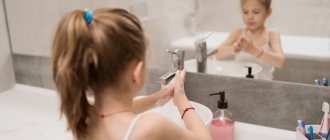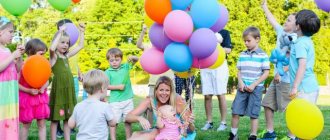MAGAZINE Preschooler.RF
Parent meeting in the senior group. Topic: “The beginning of the school year is the beginning of a new stage in the life of kindergarten and senior group students.”Winner of the all-Russian competition “The most popular article of the month” October 2017
Conditions of the competition:
Target:
- familiarizing parents with the developmental characteristics of children 5-6 years old.
Tasks:
- To develop practical skills in parents in the field of interaction with children.
- Develop interest in learning about your child, promote active interaction with him.
- Promote the emotional rapprochement of all participants in the educational process and organize their communication.
Agenda.
- The ceremonial start of the meeting. Congratulations to parents on the beginning of the school year.
- Features of the educational process in the senior group.
- Speech by the teacher: “Senior preschool age - what is it like?”
- Selecting the group's parent committee.
- Miscellaneous
Design of a mini-exhibition of board and printed games appropriate for the age of children 5-6 years old “Let’s play!”
Drawings by children on the topic: “How I spent my summer” , making a “Wonderful Flower” for parents, musical accompaniment, design of the central wall
Progress:
Game for parents “Pass your smile” . "Smile" is playing
(positive attitude)
Educator: Hello, dear parents! We have gathered today at the beginning of the new school year. Today I would like to talk specifically about our children, about their achievements and problems. We, the team of our group, want you and me to be one friendly, strong family.
I would like to remind you that we are now the senior group. Our daily routine, hours and number of classes per day have changed.
In order for the educational process to be properly organized, in our work we rely on the main regulatory documents regulating the activities of preschool educational institutions:
- Federal Law “On Education” ;
- Project - Federal State Educational Standard for Preschool Education;
- SanPin 2.4. 1. 2660-10.
- International Convention on the Rights of the Child.
Today we are working on the preschool education program “From Birth to School” edited by Veraksa N.E., Vasilyeva T.S., Komarova M.A.
Your children have gotten older, and as a result, their responsibilities have increased. And I would really like you, the parents, to take the educational process seriously.
According to Art. 18 of the Russian Federation Law on Education,
paragraph 1: “Parents are the first teachers. They are obliged to lay the foundations for the physical, moral and intellectual development of the child’s personality in early childhood.”
The age from 5 to 6 years is a new important stage in the development and upbringing of a preschool child.
Raising 5-year-old children is a qualitatively new step compared to raising children of middle preschool age; these opportunities should not be missed. A child’s success at school will largely depend on how attentively parents pay attention to solving educational problems this year.
The transition of children to the older group is associated with some changes in the conditions of their life and upbringing: they are now included in systematic and more complex collective activities (play, work, learning). Both the program and teaching methods acquire the character of educational activity.
Motor skills
From age five to six, your child makes even more significant improvements in motor skills and strength. The speed of movements continues to increase, and their coordination noticeably improves. Now he can already perform 2-3 types of motor skills at the same time: run, catch a ball, dance. The child loves to run and compete. He can play sports games on the street for more than an hour without stopping, run up to 200 m. He learns to skate, ski, rollerblade, and if he didn’t know how yet, he can easily master swimming.
Emotional development
The child already has his own ideas about beauty. Some people enjoy listening to classical music. The baby learns to throw out some of his emotions in his favorite activities (drawing, dancing, games, etc.), and strives to manage them, tries to restrain and hide his feelings (but he may not always be able to do this.) The most difficult thing for children is to cope with their fear .
Social development
From the age of five, a child already clearly knows his gender identity and even in games does not want to change it. At this age, a very important place in the upbringing of a boy is given to the father, and for girls - to the mother. Dads teach their sons to be courageous, mothers teach their daughters to be feminine. Only these qualities inherent in childhood come harmoniously into adulthood. The baby develops ideas about the role of the opposite sex in life. A daughter learns the role of a man through her father’s behavior, and boys learn the role of a woman through communication with her mother. At this age, you should already tell in a form accessible to the baby about how he was born. The child has grown to understand such a secret. It would be better if you cut it out for him at home, otherwise the children in the yard will do it. After five years, relationships with peers become friendly. The first friends appear, usually of the same gender. He spends most of his time with them. There is some distance from parents. The child can now safely endure a short separation from loved ones.
Intellectual development
By the age of six, a child can no longer just distinguish between animals, but also divide them into wild and domestic. Can combine objects according to various characteristics, find similarities and differences between them. After five years, the child is interested not only in the names of objects, but also in what they are made of. He has his own understanding of the physical phenomena around him, he can explain what electricity and magnet are. The child is very well oriented in space: on the street, among friends
premises, home. Knows where they buy toys, food, medicine. He is trying to master the alphabet and learn to read syllables, and also continues to improve his writing in block letters. Can count (sometimes up to a hundred), add and subtract within ten.
Features of behavior
The child already has his own opinion about everything. Can explain who and why he likes or dislikes. He is observant. He is very interested in everything that happens around him. He seeks to find causes and connections between various phenomena. The baby becomes very independent. If he wants to learn something, he can engage in a new activity that interests him for more than half an hour. But it is still very difficult to purposefully switch it to different types of activities. The child uses his new knowledge in games, invents game plots himself, and easily masters complex toys (construction sets, computers). By the age of six, he masters most of the necessary skills and improves them right before your eyes - he becomes more neat, takes care of his appearance - hairstyle, clothes, helps you with the housework.
Creative development
The peak of a child's creative development. He creates without getting tired, barely waking up, turning a simple tulip into an extraordinary scarlet flower, building houses for aliens. He is very attracted to painting and can look at paintings and paints for a long time. He enjoys drawing himself, trying to copy something from a painting and come up with his own plot. At the age of five, a child expresses his feelings towards what he draws in various colors. It is believed that children's drawings are the key to a child's inner world. Now he draws a person as he really is, detailing the face with eyes for him to see, with ears for him to hear, a mouth to speak and a nose to smell. The drawn man has a neck. He already has clothes, shoes and other clothing items on him. The more similar the picture is to a real person, the more developed your child is and the better prepared he is at school.
So, taking into account the above-mentioned age characteristics of children of the 6th year of life, it is necessary to carry out the following tasks:
- develop children’s movements, achieve greater coordination, accuracy, and speed;
- cultivate independence and speed of movement during self-service;
- expand children’s ideas about social life, nature, and the work of adults, and cultivate the right attitude towards them;
- cultivate the ability to maintain a goal, follow the instructions of an adult, concentration and purposefulness;
- form separate concepts in children, develop logical thinking;
- develop children's coherent speech;
- improve artistic skills in drawing, singing, dancing, reading poetry, retelling fairy tales, stories, enrich aesthetic perceptions and experiences;
- develop children's teamwork skills
- develop children’s voluntary control of their behavior.
Well, now we will find out how you know your children. (there are pieces of paper with questions on the table) parents take turns answering.
- How long can your child count?
- Can your child distinguish between right, left hand, foot?
- In your opinion, does your child navigate the parts of the day?
- Does your child know their home address?
- Can your child name a favorite fairy tale or read a poem?
- Can your child write his own fairy tale?
- Does your child know how to take care of living objects in the surrounding world? How does he relate to animals and plants?
- Do you think your child can talk about wanting to acquire a certain profession in the future?
- What do you think: is your child polite?
- Do you think your child can compare 2-3 objects by size? (more - less, shorter - longer)
- How does your child behave when visiting?
- Can your child hold scissors correctly? Can he cut a circle out of a square and an oval out of a rectangle?
- What does your child like to draw most and does he show interest in this activity?
- Does your child have an interest in sculpting? What does he like to sculpt at home?
- What does your child tell you when he comes home from kindergarten?
- Is your child interested in speech sounds? Does he hear the first sound? Can he come up with a word for a given sound?
- Will your child be able to sympathize with the offended person and disagree with the actions of the offender?
- Can your child determine the position of objects in space relative to themselves? (in front - behind, above - below).
Selecting the group's parent committee.
| Next > |
Parent meeting in the senior group of kindergarten “How to play with a child”
4.
Category "To the parents' piggy bank." (Sukhovataya I.N.)
The teacher introduces parents to logo-mathematical games and demonstrates them.
Games with mathematical content help to develop children's cognitive interest, the ability for research and creative search, the desire and ability to learn, and develop intellectual abilities and independence.
Puzzle games, or geometric design games, have been known for a long time. These are “Tangram”, “Magic Circle”, “Vietnamese Game”, “Columbus Egg”, “Pythagoras”, “Pintamino”, etc.
Each game is a set of geometric shapes. Such a set is obtained by dividing one geometric figure (for example, a square in the game "Tangram" or a circle in the "Magic Circle") into several parts. The essence of the game is to recreate on a plane from the geometric shapes included in the set, the silhouettes of objects according to a model, according to a diagram or design. These games arouse great interest in children and contribute to the development of analytical, synthetic and planning activities.
The most effective aid for the formation of all thinking skills in a complex throughout preschool childhood are Dienesh blocks.
This is a set of 48 three-dimensional geometric shapes, varying in shape, color, size and thickness. Thus, each figure is characterized by four properties: shape, color, size and thickness. In the process of various actions with blocks, children first master the ability to operate with one property of figures, compare them, classify and generalize according to one property, then according to two properties at once, and a little later - according to three. With logical blocks, the child performs various actions: lays them out (according to a model, according to an algorithm, according to a scheme, according to conditions), swaps them, removes them, gives their characteristics, divides them between “quarreling” toys, etc., and reasons along the way.
“Cuisenaire’s colored sticks” are also called “colored numbers”, since each stick represents one of the natural numbers within 10. With the help of colored numbers, children become familiar with the sequence of numbers in the natural series, with the composition of a number of ones and two smaller numbers, and master counting forward and backward, compare numbers, can master the arithmetic operations of addition, subtraction, multiplication and division, learn to measure objects using a conventional measure.
Also, one of the effective means of developing intellectual abilities is a system of games and exercises with counting sticks. Children can lay out given figures, objects from a certain number of sticks, a rhythmic pattern, figures of people, animals, cars, perform tasks of rearranging sticks in order to obtain a new image, and analyze images. Children like games with sticks: “Who can put together three figures faster?”, “Find what has changed”, “Use six sticks for a figure”, “Make two squares from seven sticks”, etc.


